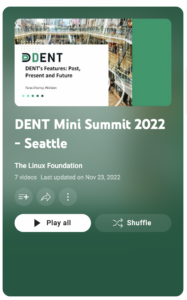- Newest version of DENT, an open source Network Operating System under the Linux Foundation, enables users to securely manage and operate their distributed enterprise edge network deployments
- Release implements a new LTS kernel, following kernel upstream best practices
- DENT 3.0 ushers in the technical community’s move to a rapid innovation/release cycle, enabling earlier access to requested features in a modern DevOps world that includes 802.1x, QoS, IGMP Snooping, and Egress Policing
SAN FRANCISCO, 19 April 2023 —The DENT project, an open source network operating system utilizing the Linux Kernel, Switchdev, and other Linux based projects, today announced the launch of DentOS 3.0, code-named “Cynthia,” a cutting-edge network operating system (NOS) that’s now moved to a more rapid release cycle. This innovative operating system provides a flexible and customizable platform for network administrators to manage their networks, while also leveraging the power of open source technologies.
DENT provides access to open source- based switches at a lower cost and with more flexibility compared to proprietary switches with locked ecosystems. Network wiring closets in many facilities–including retail stores, warehousing, remote locations, enterprises, and small and mid-sized businesses–are often small, requiring a compact solution for network management. Additionally, staff expertise may be limited, and branch-office switches from leading suppliers can require costly contracts. DENT can be easily deployed on white-box hardware in small spaces, providing an efficient and cost-effective solution for network management. As a result, DENT deployment can significantly enhance network management in a wide range of environments, providing greater efficiency, reliability, and scalability.
DENT 3.0 builds on a solid foundation of fundamental OS features for networking, three years in the making, that include SwitchDev, POE+ and others.
Specific feature updates in 3.0 include:
- Traffic Control (TC) Persistence
- Enables traffic control commands and configuration data across boots simplifies configuration and set up
- New Kernel 5.15(LTS)
- Increased security, management with new Kernel software
- Rapid DevOps, providing early access to:
- IEEE 802.1x :security/patches in kernel and Switchdev
- QoS: (Mgmt): enables prioritization and optimization of bandwidth usage in remote locations
- IPv6: for continued expansion and support of more IOT Devices
- IGMP Snooping: no router required at enterprise location
- Egress Policer
DENT in Deployment
DentOS enables Amazon’s Just Walk Out Technology to connect and manage thousands of devices like cameras, sensors, entry and exit gates, and access points on the network edge. For more information, please see this presentation from ONE Summit 2022, as well as content from the latest DENT Mini-Summit, co-located at ONE Summit.
“We are pleased to leverage the DENT open-source platforms to power networking infrastructure to enable customers to skip check-out lines with our Just Walk Out Technology,” said Jason Long, head of Networking for Amazon Physical Retail Technology and chairman of the DENT Board. “DENT enabled us to reduce our networking costs by giving us access to open-source switches that allowed Amazon to efficiently deploy new hardware and software whenever we need instead of waiting for a bug fix from a third-party vendor”.
“Adoption and deployment by the world’s largest e-commerce leader with its Just Walk Out Technology is a shining example of the power of open source,” said Arpit Joshipura, general manager, Networking, Edge and IoT, the Linux Foundation. “In just three years, the DENT community created a working platform for disaggregated networks to power multiple device locations at the edge, now used by top retailers to streamline operations. This undertaking is only possible by the power of collaborative open source development.”
Amazon joins Delta, Edgecore Networks, and Marvell as premiere members of DENT, which is only enabled by important contributions from across the community and wider ecosystem.
To download and start testing DENT 3.0 today, visit: https://github.com/dentproject/dentOS
To join DENT technical working groups, visit: https://lists.dent.dev/g/tsc/calendar
Ecosystem Support for DentOS 3.0:
“With its cost-effective cloud managed networking products, Quantum Networks has established itself as a reliable community partner, especially in emerging markets,” said Mukesh Majithia, director (Technical), Quantum Networks, a user of DENT Project. “Our collaboration with the DENT community and Sartura is intended to build a roadmap for market-required features. Being able to provide a quality service to our customers through the use of Open Source technologies is what sets us apart from traditional vendors at a lower price.”
“Having a reliable verification process is paramount in networking, and Delta is proud to support DENT in their vision for OS verification. Investing in open-source hardware is an investment in the industry’s community, and we believe there will be numerous developments in the coming years that push the entire industry forward,” said Charlie Wu, VP of Data Center RBU, Delta Electronics.
“As a key contributing company to the DENT test working group, it is our pleasure to see another successful DENT 3.0 release and the platform becoming a robust network operating system with Amazon’s successful deployment in Just Walk Out Technology,” said Dean Lee, senior director, Cloud Solution Team at Keysight Technologies. “With the growing test coverage in Keysight’s system integration test lab, we are confident that onboarding new users will accelerate resulting in more successful DENT deployments in 2023.”
“By concentrating on switchdev and mainline Linux kernel support, DENT has laid a solid basis for the future of Linux-powered networking. There is no doubt that Linux-based ecosystems are the best choice for any buyer,” said Luka Perkov, CEO, Sartura. “Our efforts in the Upstream Working Group will be aimed at lowering the gap between SAI and mainline Linux as the DENT ecosystem continues to evolve.”
“We are pleased to be part of DENT’s third major release, bringing even more features that enable more streamlined operations across multiple devices at the edge,” said Larry Ho, VP of Software Engineering at Edgecore. “DENT has established a strong foundational platform for Linux and open source based network operations that is only possible via collaborative development.”
About The Linux Foundation
The Linux Foundation is the organization of choice for the world’s top developers and companies to build ecosystems that accelerate open technology development and industry adoption. Together with the worldwide open source community, it is solving the hardest technology problems by creating the largest shared technology investment in history. Founded in 2000, The Linux Foundation today provides tools, training and events to scale any open source project, which together deliver an economic impact not achievable by any one company. More information can be found at www.linuxfoundation.org.
The Linux Foundation has registered trademarks and uses trademarks. For a list of trademarks of The Linux Foundation, please see our trademark usage page: https://www.linuxfoundation.org/trademark-usage.
Linux is a registered trademark of Linus Torvalds.
# # #
Media Contact
Jill Lovato
The Linux Foundation
jlovato@linuxfoundation.org



 The DENT community held its first Mini-Summit, “NOS for the Distributed Edge: A Mini-Summit on DENT Ecosystem,” in November 2022 alongside ONE Summit. The mini-summit featured 7 session presentations with almost 70 attendees (both in-person and virtually).
The DENT community held its first Mini-Summit, “NOS for the Distributed Edge: A Mini-Summit on DENT Ecosystem,” in November 2022 alongside ONE Summit. The mini-summit featured 7 session presentations with almost 70 attendees (both in-person and virtually).